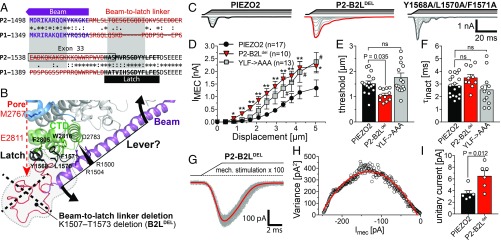Fig. 3.
The beam-to-latch linker limits ion permeation of PIEZO2. (A) Sequence alignment of the indicated regions of PIEZO2 and PIEZO1. AAs that were deleted in the B2Ldel mutants are crossed out. (B) Magnified view of the CTD and the proximal end of the beam of a single protamer of the PIEZO2. Note that the beam-to-latch linker region is intrinsically disordered and has not been structurally resolved yet and is thus depicted as an imaginary structure (red line). The gray shaded areas framed by the dashed lines mark the region that was removed in the PIEZO2-B2Ldel mutant. (C) Example traces of PIEZO2-WT (Left), PIEZO2-B2Ldel (Center), and YLF→AAA-mediated currents evoked by a series of mechanical stimuli of increasing magnitude in N2a-P1KO cells. (D) Displacement–response curves (mean ± SEM peak amplitudes) of the same mutants. The mean current amplitudes at different stimulus strengths were compared using one-way ANOVA and Dunnett’s multiple-comparison test. (E) Comparison of the mean ± SEM activation thresholds of the mechanically activated currents mediated by the indicated channel mutants using one-way ANOVA and Dunnett’s multiple-comparison test. (F) Comparison of the mean ± SEM inactivation time constants (τinact) using one-way ANOVA and Dunnett’s multiple comparison test. (G) Superimposed example traces (gray) of currents from the PIEZO2-B2Ldel mutant evoked by 100 consecutive and identical mechanical stimuli. The mean response waveforms obtained by averaging all currents are shown in red. (H) The variance of the difference between the measured and the scaled mean waveform at each sampling point is plotted against the current amplitude of the mean scaled waveform in 1-pA bins and fitted using the equation: σ2 = σ02 + iI – I2/N, where i is the single-channel current (see Materials and Methods and SI Appendix, Fig. S3 for details). (I) Comparison of the mean unitary currents ± SEM of PIEZO2-WT and B2Ldel using Student’s t test.

